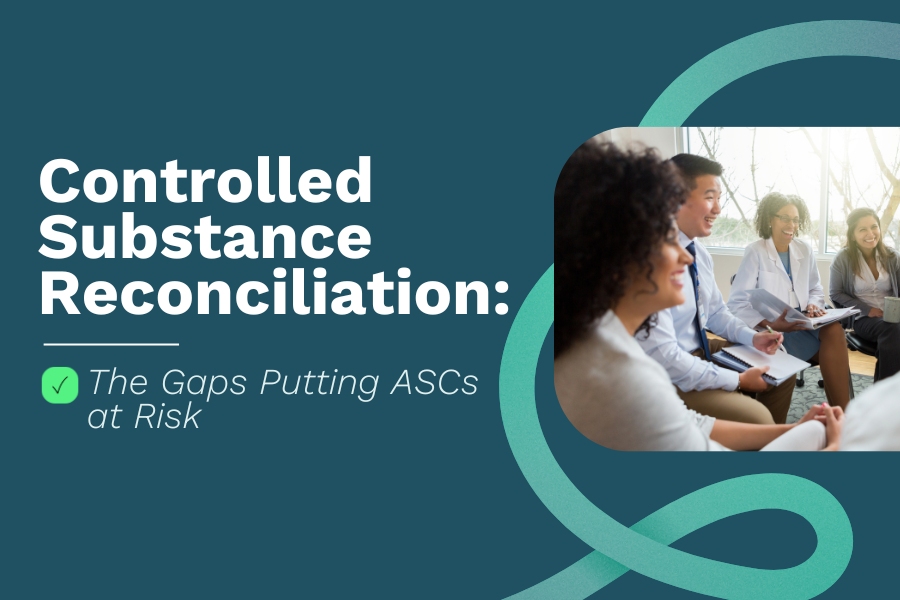Improving the Controlled Substance Reconciliation Process
Why the Controlled Substance Reconciliation Process Matters
In today’s fast-paced ambulatory surgery center (ASC) environment, maintaining a reliable controlled substance reconciliation process is more critical than ever. Despite their best efforts, many ASCs still face challenges that put patients, staff, and compliance at risk.
With DEA oversight tightening and the opioid crisis impacting healthcare systems nationwide, improving reconciliation accuracy is no longer just a compliance issue—it’s a patient safety priority.
The Reality Gap in Reconciliation
Nearly every ASC uses controlled substances for anesthesia and pain management, yet discrepancies often arise between what’s documented and what’s actually used. These inconsistencies create dangerous vulnerabilities in the controlled substance reconciliation process.
Common reconciliation failures include:
Incomplete Documentation: Gaps between recorded and actual drug usage make diversion harder to detect.
Inconsistent Procedures: Staff often follow varying reconciliation methods, breaking the chain of custody.
Paper-Based Workflows: Outdated systems or disconnected EHRs prevent accurate tracking.
Verification Shortcuts: Staff may pre-sign, skip, or rush waste documentation in busy OR settings.
Delayed Reconciliation: Performing reconciliations only at shift changes allows discrepancies to grow.
The Risks of a Weak Reconciliation Process
When the controlled substance reconciliation process fails, the consequences extend far beyond compliance.
Patient Safety Risks: Diversion may result in inadequate pain control or anesthesia issues.
Staff Health Concerns: Diversion is often linked to addiction or stress among clinical personnel.
Regulatory Penalties: Noncompliance with DEA or accreditation standards can result in fines, registration loss, or criminal penalties.
Reputational Damage: A single diversion incident can harm an ASC’s credibility in the community.
Building a Safer Controlled Substance Reconciliation Process
A strong controlled substance reconciliation process requires structure, accountability, and the right technology.
1. Standardize Procedures
Develop clear, step-by-step reconciliation workflows. Define who is responsible, when to reconcile, and how discrepancies should be documented.
2. Strengthen Accountability
Use dual verification for all controlled substance counts and waste. Require witness validation for each transaction to prevent human error or fraud.
3. Leverage Technology
Integrate medication management software that tracks controlled substances from receipt to waste. Automated dispensing cabinets with biometric access help reduce diversion and improve accuracy.
(Suggested internal link: /solutions/medication-management)
4. Educate and Re-Educate Staff
Offer ongoing training on proper reconciliation steps and diversion warning signs. Regular refreshers foster awareness and promote a culture of compliance.
5. Conduct Surprise Audits
Perform unannounced audits across shifts to identify discrepancies quickly and reinforce accountability.
6. Create Clear Escalation Protocols
When discrepancies occur, ensure staff know the exact steps for investigation, documentation, and escalation to compliance officers or leadership.
Implementing Improvements Step-by-Step
Improving your controlled substance reconciliation process doesn’t have to happen overnight. Strategic, phased implementation ensures smoother adoption.
Conduct a Gap Analysis: Identify where your current process fails—through documentation reviews, staff feedback, and workflow observation.
Prioritize High-Risk Medications: Focus on anesthesia and opioid management first.
Set Measurable KPIs: Track metrics such as “perfect reconciliations” or “time to discrepancy resolution.”
Phase the Rollout: Introduce improvements gradually to build staff confidence and minimize disruption.
The Path Forward for ASCs
As healthcare regulations evolve, ASCs that prioritize a robust controlled substance reconciliation process will lead the way in compliance and patient safety.
This isn’t just about meeting regulatory expectations—it’s about creating a safer, more accountable environment for patients and staff alike.
By standardizing workflows, integrating technology, and building accountability, your ASC can eliminate reconciliation gaps and strengthen its compliance foundation.
Ready to modernize your controlled substance reconciliation process?
Schedule a quick call to see how MedServe helps ASCs improve safety, accuracy, and compliance.

